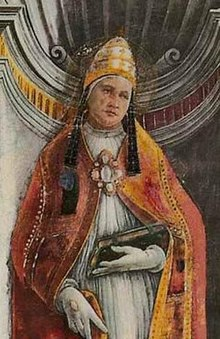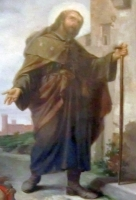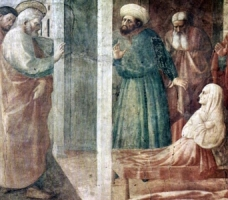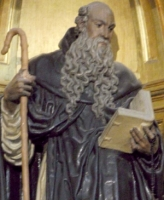St. Quodvultdeus
Feast
26 October (Roman calendar);
8 January (calendar of Carthage);
19 February (calendar of Naples)
Death: ~450
Quodvultdeus (Latin for "what God wills", died c. 450 AD) was a fifth-century church father and bishop of Carthage who was exiled to Naples. He was known to have been living in Carthage around 407 and became a deacon in 421 AD. He corresponded with Augustine of Hippo, who served as Quodvultdeus' spiritual teacher.[1] Augustine also dedicated some of his writings to Quodvultdeus.[1]
Quodvultdeus was exiled when Carthage was captured by the Vandals led by King Genseric, who followed Arianism. Tradition states that he and other churchmen (such as Gaudiosus of Naples) were loaded onto leaky ships that landed at Naples around 439 AD and Quodvultdeus established himself in Italy.[1] He would go on to convert dozens of Arian Goths to the Catholic Faith in his lifetime.
One of the mosaic burial portraits in the Galleria dei Vescovi in the Catacombs of San Gennaro depicts Quodvultdeus
St. Evaristus
புனிதர் எவரிஸ்டஸ்
(St. Evaristus)
ஐந்தாம் திருத்தந்தை:
(5th Pope)
பிறப்பு: ஏப்ரல் 17, 44
பெத்லகேம், யூதேயா
(Bethlehem, Judea)
இறப்பு: கி.பி சுமார் 107
ரோமை, ரோமப் பேரரசு
(Rome, Roman Empire)
ஏற்கும் சமயம்:
ரோமன் கத்தோலிக்க திருச்சபை
(Catholic Church)
கிழக்கு மரபுவழி திருச்சபை
(Eastern Orthodox Church)
இயற்பெயர்: எவரிஸ்டஸ் (அல்லது) அரிஸ்டஸ்
நினைவுத் திருநாள்: அக்டோபர் 26
புனிதர் எவரிஸ்டஸ் அல்லது அரிஸ்டஸ் (Aristus) கத்தோலிக்க திருச்சபையின் ஐந்தாம் திருத்தந்தையாவார். திருத்தந்தை புனிதர் “முதலாம் கிளமெண்ட்” (Pope Clement I) இவருக்கு முன்னர் திருத்தந்தையாகப் பதவியிலிருந்தவராவார். திருத்தந்தை புனிதர் “முதலாம் அலெக்சாண்டர்” (Pope Alexander I) இவருக்குப் பிறகு ஆட்சியிலிருந்தவராவார். தொடக்க கால கிறிஸ்தவ அறிஞர்களான இரனேயுஸ் மற்றும் செசரேயா யூசேபியஸ் (Eusebius) இச்செய்தியைத் தருகின்றனர்.
எவரிஸ்டஸ் என்னும் பெயர் கிரேக்க மொழியில் "இனிமை மிக்கவர்" என்று பொருள்படும்.
வாழ்க்கைக் குறிப்புகள்:
திருத்தந்தை எவரிஸ்டஸின் ஆட்சிக்காலம் குறித்து ஒத்த கருத்து இல்லை. "திருச்சபை வரலாறு" என்னும் நூலில் யூசேபியஸ் அந்த ஆட்சிக்காலம் கி.பி. 99 முதல் கி.பி. 108 வரை நீடித்தது என்கிறார். "லிபேரியன் குறிப்பேடு" என்னும் நூல் எவரிஸ்டஸின் பெயரை "அரிஸ்டஸ்" என்று குறிப்பிடுவதோடு, அவரது ஆட்சிக்காலம் கி.பி. 96 முதல் கி.பி. 108 வரை தொடர்ந்ததாகக் கூறுகிறது.
"திருத்தந்தையர் நூல்" (Liber Pontificalis) என்னும் ஏடு தருகின்ற கீழ்வரும் செய்திகள் உறுதிப்படுத்தப்படவில்லை. அதன்படி, கிரேக்கப் பின்னணியைச் சார்ந்த எவரிஸ்டஸ், யூதத் தந்தைக்கு பெத்லகேமில் மகனாகப் பிறந்தார். மறைச்சாட்சியாக உயிர் துறந்தார். ரோமத் திருச்சபையைப் பல பங்குகளாகப் பிரித்து குருக்களை நியமித்தார். 15 ஆயர்களையும் 17 குருக்களையும் 2 திருத்தொண்டர்களையும் ஏற்படுத்தினார்.
மேற்கூறிய ஏடு குறிப்பிடுவது போல, எவரிஸ்டஸ், புனித பேதுருவின் கல்லறையின் அருகே அடக்கம் செய்யப்பட்டார் என்று உறுதியாகத் தெரிகிறது. அவரது பணியிடம் 19 நாள்கள் வெறுமையாய் இருந்தது.
ரோமத் திருச்சபையின் முதல் திருத்தந்தையர்களின் பெயர்கள் திருப்பலியின் நற்கருணை மன்றாட்டில் இருக்க, எவரிஸ்டஸின் பெயர் மட்டும் அங்கு காணப்படவில்லை. இதிலிருந்து, இத்திருத்தந்தை பற்றிய உறுதியான வரலாற்றுச் செய்திகள் தெரியாத நிலை திருச்சபை வரலாற்றின் முதல் நூற்றாண்டுகளிலிருந்தே நிலவி வந்துள்ளது எனத் தெரிகிறது.
புனிதராகப் போற்றப்படுதல்:
எவரிஸ்டஸ் எவ்வாறு மறைச்சாட்சியாக உயிர்துறந்தார் என்பது பற்றியும் உறுதிப்பாடு இல்லை. கத்தோலிக்கம் மற்றும் கிழக்கு மரபுவழி திருச்சபைகள் இவரை புனிதராகப் போற்றுகின்றன. இவர்தம் நினைவுத் திருவிழா அக்டோபர் 26 ஆகும். 1969ம் ஆண்டிலிருந்து இவரது பெயர் கத்தோலிக்க திருச்சபையின் பொது நாள்காட்டியில் மறைச்சாட்சிகள் பட்டியலிலிருந்து அகற்றப்பட்டு, இப்போது தனி நாள்காட்டியில் மட்டுமே உள்ளது.
Papacy began c. 99
Papacy ended c. 107
Predecessor Clement I
Successor Alexander I
Personal details
Born Bethlehem, Judea
Died c. 107
Rome, Roman Empire
Sainthood
Feast day 26 October
Pope Evaristus was the bishop of Rome from c. 99 to his death c. 107.[1][2] He was also known as Aristus and is venerated as a saint in the Eastern Orthodox Church,[3] the Catholic Church, and Oriental Orthodoxy. It is likely that John the Apostle died during his reign period, marking the end of the Apostolic Age.
Biography
According to the Liber Pontificalis, he was born to a family of Greek Jews in Bethlehem; His father was named Judah.[4] He was elected during the reign of the Roman emperor Trajan, and succeeded Clement I in the See of Rome. He has divided the titles among the priests in the city of Rome, and ordained seven deacons to keep the bishop preaching, on account of the style of truth.
According to the book Sullivan, Reverend John F. (1918). The Externals of the Catholic Church. Aeterna Press. Evaristus decreed that “in accordance with Apostolic tradition marriage should be celebrated publicly and with the blessing of the priest”.
Eusebius, in his Church History IV, I, stated that Evaristus died in the 12th year of the reign of Emperor Trajan after holding the office of bishop of the Romans for eight years.
Liber Pontificalis further describes him as the one "crowned with martyrdom".[5] The same is indicated also by the book "The lives and times of the popes".[6] However, in the Roman Martyrology he is listed without the martyr title, with a feast day on 26 October.[7]
Pope Evaristus is buried near the body of Saint Peter in the Vatican, in the Saint Peter's tomb under the Saint Peter's Basilica
St. Demetrius of Thessaloniki
Feastday: October 26
Patron: of Thessaloniki, Greece patron of soldiers, patron of the Crusades
Birth: 270
Death: 306
Saint Demetrius (or Demetrios) of Thessalonica (Greek: Ἅγιος Δημήτριος τῆς Θεσσαλονίκης, Hágios Dēmḗtrios tēs Thessaloníkēs[a]), also known as the Holy Great-Martyr Demetrius the Myroblyte (meaning 'the Myrrh-Gusher' or 'Myrrh-Streamer';[b] 3rd century – 306), was a Greek Christian martyr of the early 4th century AD.
During the Middle Ages, he came to be revered as one of the most important Orthodox military saints, often paired with Saint George of Lydda. His feast day is 26 October for Eastern Orthodox Christians, which falls on 8 November [NS] for those following the old calendar. In the Roman Catholic church he is most commonly called "Demetrius of Sermium" and his memorial falls on 8 October.
Veneration of sainthood and celebrations
Relics of Saint Demetrius at the Hagios Demetrios Basilica in Thessaloniki
Most historical scholars follow the hypothesis put forward by Bollandist Hippolyte Delehaye (1859–1941), that his veneration was transferred from Sirmium[5] when Thessaloniki replaced it as the main military base in the area in 441/442 AD. His very large church in Thessaloniki, the Hagios Demetrios, dates from the mid-5th century.[6] Thessaloniki remained a centre of his veneration, and he is the patron saint of the city.
After the growth of his veneration as saint, the city of Thessaloniki suffered repeated attacks and sieges from the Slavic peoples who moved into the Balkans, and Demetrius was credited with many miraculous interventions to defend the city. Hence later traditions about Demetrius regard him as a soldier in the Roman army, and he came to be regarded as an important military martyr. Unsurprisingly, he was extremely popular in the Middle Ages. Disputes between Bohemond I of Antioch and Alexios I Komnenos appear to have resulted in Demetrius being appropriated as patron saint of crusading.[7]
Demetrius was also venerated as patron of agriculture, peasants and shepherds in the Greek countryside during the Middle Ages. According to historian Hans Kloft, he had inherited this role from the pagan goddess Demeter. After the demise of the Eleusinian Mysteries, Demeter's cult, in the 4th century, the Greek rural population had gradually transferred her rites and roles onto the Christian saint Demetrius.[2]
Most scholars still believe that for four centuries after his death, Demetrius had no physical relics, and in their place an unusual empty shrine called the "ciborium" was built inside Hagios Demetrios. What were purported to be his remains subsequently appeared in Thessaloniki, but the local archbishop John, who compiled the first book of the Miracles ca. 610, was publicly dismissive of their authenticity.[8] The relics were assumed to be genuine after they started emitting a liquid and strong-scented myrrh. This gave Demeterius the epithet Myroblyte.[3][c]
15th-century icon of St Demetrius (Russian State Museum, Saint Petersburg)
In the Russian Orthodox Church, the Saturday before the Feast of Saint Demetrius is a memorial day commemorating the soldiers who fell in the Battle of Kulikovo (1380), under the leadership of Demetrius of the Don. This day is known as Demetrius Saturday.[10] Demetrius was a patron saint of the Rurik dynasty from the late 11th century on. Izyaslav I of Kiev (whose Christian name was Dimitry) founded the first East Slavic monastery dedicated to this saint.
The Bulgarian Orthodox Church and the Romanian Orthodox Church revere Demetrius on 26 October (Димитровден Dimitrovden in Bulgarian); meanwhile the Serbian Orthodox Church and Macedonian Orthodox Church (Ohrid) and the Coptic Church have a feast on 8 November (called Митровдан in Serbian and Митровден in Macedonian).
The names Dimitry (Russian), Dimitar (Bulgarian), Mitri (short form of Dimitri in Lebanon) are in common use.
The hagiographic cycles of the Great Martyr Demetrius of Thessaloniki include depictions of scenes from his life and his posthumous miracles.[11] Demetrius was initially depicted in icons and mosaics as a young man in patterned robes with the distinctive tablion of the senatorial class across his chest. Miraculous military interventions were attributed to him during several attacks on Thessaloniki, and he gradually became thought of as a soldier: a Constantinopolitan ivory of the late 10th century shows him as an infantry soldier (Metropolitan Museum of Art). But an icon of the late 11th century in Saint Catherine's Monastery on Mount Sinai shows him as before, still a civilian. In Byzantine icons he is depicted in military dress, either standing or riding a horse.[12]
Another Sinai icon, of the Crusader period and painted by a French artist working in the Holy Land in the second half of the 12th century, shows what then became the most common depiction. Demetrius, bearded, rather older, and on a red horse, rides together with George, unbearded and on a white horse.[13] Both are dressed as cavalrymen. Also, while George is often shown spearing a dragon, Demetrius is depicted spearing the gladiator Lyaeus (Λυαίος Lyaíos), who according to story was responsible for killing many Christians. Lyaeus is commonly depicted below Demetrius and lying supine, having already been defeated; Lyaeus is traditionally drawn much smaller than Demetrius. In traditional hagiography, Demetrius did not directly kill Lyaeus, but rather through his prayers the gladiator was defeated by Demetrius' disciple, Nestor.[11]
A modern Greek iconographic convention depicts Demetrius with the Great White Tower in the background. The anachronistic White Tower acts as a symbolic depiction of the city of Thessaloniki, despite having been built in the 16th century, centuries after his life, and the exact architecture of the older tower that stood at the same site in earlier times is unknown. Again, iconography often depicts saints holding a church or protecting a city.
According to hagiographic legend, as retold by Dimitry of Rostov in particular, Demetrius appeared in 1207 in the camp of tsar Kaloyan of Bulgaria, piercing the king with a lance and so killing him. This scene, known as Чудо о погибели царя Калояна ("the miracle of the destruction of tsar Kaloyan") became a popular element in the iconography of Demetrius. He is shown on horseback piercing the king with his spear,[14] paralleling the iconography (and often shown alongside) of Saint George and the Dragon.
Blessed José Gregorio Hernandez-Cisneros
Memorial Note
his memorial would traditionally been on 29 June, but it was changed so as to not conflict with the solemnity of Saints Peter and Paul celebrated on that day
Profile
The eldest of six children born to Benigno María Hernández Manzaneda and Josefa Antonia Cisneros Mansilla; he was baptized on 30 January 1865 and confirmed on 6 December 1867. Beginning at age 18, he studied medicine at the University of Caracas, Venezuela, graduating on 29 June 1888, and then in Paris, France and Berlin, Germany. Feeling called to religious life, José joined the Secular Franciscans on 7 December 1899, and began investigating becoming a Carthusian monk. After some theology studies in Rome, Italy, he was forced to return to Caracas for health reasons. José took this as a sign that he should give up the idea of religious life, and serve an apostolate as a physician. That’s how he spent the rest of his life - single, celibate, prayerful and dedicated to caring for the poor for free.
Born
26 October 1864 in Isnotú, Trujillo, Venezuela
Died
• hit by a car on 29 June 1919 in Caracas, Venezuela while delivering medications he had purchased for an elderly patient
• relics enshrined in the church of Our Lady of Candelaria in Caracas
Beatified
• 30 April 2021 by Pope Francis
• beatification celebrated at the Universidad Central de Venezuela, Caracas, Venezuela, Apostolic Nuncio Aldo Giordano presiding
• his beatification miracle involved the healing of Yaxury Solorzano, a 10 year old girl in the diocese of San Fernando de Apure, Venezuela who had been shot in the head with a shotgun during an armed robbery on 10 March 2017; she was badly injured, with pellets in her brain; because there was delay in obtaining a neurosurgeon, her mother began to pray for the intercession of then Venerable José Gregorio; the girl improved, surgery was cancelled and she was released a few days later in good health
Blessed Damian dei Fulcheri
Also known as
• Damian of Finario
• Damian of Fulcheri
• Damian of Finale
• Damian of Finarium
• Damiano, Damianus
Profile
Born to wealthy Italian nobility. When he was kidnapped as an infant by a mentally ill man, his parents prayed fervently to the Virgin Mary for help; searchers were led to his hiding place by a miraculous light, and the baby was returned unharmed. Damien joined the Dominicans at Savona, Italy. Priest. Famous preacher throughout Italy with hundreds converted during his missions. Known as a miracle worker in life, there were miracles reported at his tomb, and he became the object of popular devotion almost immediately on his death.
Born
at Fulcheri, Liguria, Italy
Died
1484 at Modena, Reggio d'Emilia, Italy of natural causes
Beatified
4 August 1848 by Pope Pius IX (cultus confirmed)
Saint Alfred the Great
புனிதர் முதலாம் ஆல்ஃபிரட்
ஆங்கிலோ-சாக்ஸன் இன அரசர்:
(King of the Anglo-Saxons)
ஆட்சிகாலம்: ஏப்ரல் 23, 871 - அக்டோபர் 26, 899
இவருக்கு முன்னர் பதவி வகித்தவர்: எத்தெல்பெர்ட் (Æthelred)
இவருக்குப் பிறகு பதவி வகித்தவர்: மூத்த எட்வர்ட் (Edward the Elder)
பிறப்பு: கி.பி. 849
வேன்டேஜ், பெர்க்ஷயர்
(Wantage, Berkshire)
இறப்பு: அக்டோபர் 26, 899 (வயது சுமார் 50)
வின்செஸ்டர் (Winchester)
நினைவுத் திருநாள்: அக்டோபர் 26
பேரரசர் ஆல்ஃபிரட், ஆங்கிலோ - சாக்சான் அரசின், (Anglo-Saxons) வெசெக்ஸ் (Wessex) பகுதியை கி.பி. 871ம் ஆண்டு முதல் கி.பி. 899ம் ஆண்டு வரை ஆண்ட அரசர் ஆவார்.
வெசக்ஸின் அரசன் எதெல்வுல்ஃப் (King Æthelwulf of Wessex) மற்றும் அவரது முதல் மனைவியான “ஒஸ்பூர்” (Osburh) ஆகியோரது கடைசி மகனாகப் பிறந்தவர் ஆல்ஃபிரட் ஆவார். கி.பி. 853ம் ஆண்டு, தமது நான்கு வயதில் ரோம் நகர் அனுப்பப்பட்ட இவர், திருத்தந்தை நான்காம் லியோவால் (Pope Leo IV) அரசனாக அபிஷேகம் செய்விக்கப்பட்டார். ஆல்ஃபிரட், தமது குழந்தைப் பருவத்தில், சாக்ஸன் கவிதைகள் (Saxon poems) கொண்ட ஒரு புத்தகத்திலுள்ள கவிதைகளை மனப்பாடம் செய்து தமது தாயாரிடம் ஒப்பித்து, அந்த புத்தகத்தை பரிசாக வென்ற கதையை ஆயர் “ஆஸ்செர்” (Bishop Asser) கூறுகிறார்.
இவரது அண்ணன் “எதல்ரெட்” (Æthelred) இறந்தபின் அரியணை ஏறிய ஆல்ஃபிரட் மிகத் திறமையான ஆட்சியாளராவார். ஆட்சிப் பொறுப்பை ஏற்றபின் வில்டன் என்ற இடத்தில் நடந்த போரில் டேனியர்களிடமிருந்து வெசக்ஸ் நாட்டைக் காத்த பெருமைக்குரியவர். ஆங்கிலோ - சாக்சானிய அரசர்களுல் முதன் முதலில் பேரரசர் என அழைக்கப்பட்ட பெருமைக்குரியர் இவரே ஆவார். இவருடைய வாழ்க்கை வரலாறு “வெல்ஷ்” (Welsh) அறிஞரும், ஆயருமான “ஆஸ்செர்” (Asser) என்பவரால் ஒன்பதாம் நூற்றாண்டில் எழுதப்பட்டது.
தனது நாட்டில் கல்வி, அமைதி, ஒழுங்கு, சட்டம், இராணுவம் ஆகியவை நிலைபெற அரும்பணியாற்றினார். டேனிஷ் (Danish) படையினரால் மீண்டும் அச்சுறுத்தல்கள் ஏற்படாதிருக்குமாறு தமது இராச்சியத்தின் பாதுகாப்பை கட்டியெழுப்பினார். அடிக்கடி கடலோரப்பகுதிகளில் தொல்லைகள் தந்த டேனிஷ் (Danish) படையினரை ஒடுக்குவதற்காக கடற்படையையும் நிறுவினார். தமது இராணுவத்தை மறுசீரமைத்த அவர், தெற்கு இங்கிலாந்து முழுவதும் நன்கு பாதுகாக்கப்பட்ட குடியேற்றங்களின் ஒரு தொடரை கட்டமைத்தார்.
கல்வியின் முக்கியத்துவத்தில் வலுவான நம்பிக்கை கொண்டிருந்த பேரரசர் ஆல்ஃபிரெட், தமது முப்பது வயதில் இலத்தீன் மொழியைக் கற்றார். இவர், சிறந்த கல்வியாளராகவும், சிறந்த நிர்வாகியாகவும், கருணையுள்ளம் கொண்டவராகவும் விளங்கினார். கற்றறிந்த மற்றும் இயற்கையாகவே ஒரு கருணையும் இரக்கமுமுள்ள மனிதனாக புகழ் பெற்றவர் ஆவார். கல்வியை ஊக்குவித்த இவர், ஆரம்பக் கல்வியில் இலத்தீன் மொழியை விட ஆங்கில மொழியையே ஊக்குவித்தார். தமது அரசியலின் சட்ட அமைப்பு, இராணுவ அமைப்பு மற்றும் அவரது மக்களின் வாழ்க்கைத் தரத்தை மேம்படுத்த பெரிதும் பாடுபட்டார்.
கி.பி. 899ம் ஆண்டு, அக்டோபர் மாதம் மரித்த பேரரசர் ஆல்ஃபிரட், அவரது தலைநகரான வின்செஸ்டரில் (Winchester) அடக்கம் செய்யப்பட்டார்.
Profile
Youngest of five sons of King Ethelwulf of Wessex. Ideal Christian king of Wessex, he came to the throne during a Danish invasion. Alfred defeated the Danes and preserved the growth of the Church in England. Patron of learning, he established a court school, invited British and foreign scholars to work there. Personally translated several religious works into Anglo-Saxon. His laws made no distinction between British and Welsh subjects, a first.
Born
849 at Wantage, Berkshire, England
Died
26 October 899 of natural causes
Writings
• "The Consolation of Philosophy" of Boethius
• "The History of the World" of Orosius
• "Ecclesiastical History" of Bede
• "Pastoral Rule" of Saint Gregory the Great
• "Dialogues" of Saint Gregory the Great
Saint Cedd
Also known as
Cedda, Cedde, Ceddus, Ceddi, Ceadwalla
Profile
Brother of Saint Chad and Saint Cynibild; his brother Caelin was also a priest. Benedictine monk at Lindisfarne, England. Spiritual student of Saint Aidan of Lindesfarne. Priest. Missionary to the Midlands of England in 653, sent by King Oswiu of Northumbria with three other priests at the request of convert King Peada of the Middle Angles. Worked with Saint Diuma. Missionary in Essex by request of converted King Sigebert of the East Angles. Bishop of the East Saxons, consecrated by Saint Finan of Iona. Founded churches and monasteries at Bradwell-on-the-Sea, Lastingham, and Tilbury, and served as abbot of the house in Lastingham. Attended the Synod of Whitby in 664 where he acted as an interpreter, and at which he accepted Roman Easter observance. In his old age he retired to the monastery at Lastingham, Yorkshire.
Born
Northumbria, England
Died
• 26 October 664 at Lastingham, Yorkshire, England of plague
• buried at Lastingham
• relics later relocated next to the altar in the new church at Lastingham
Representation
• bishop with chalice and abbot's staff
• with Saint Chad
• with Saint Diuma
Blessed Bonaventura of Potenza
Also known as
• Bonaventure of Potenza
• Carlo Antonio
• Carlo Antonio Gerardo Lavanga
• Karl Antonius
Profile
Joined the Friars Minor Conventual at Nocera, Italy at age 15. Home missioner in southern Italy, serving from convents in Campania Aversa, Maddaloni, Amalfi, Ischia, Nocera Inferiore, Sorrento, Naples and finally, Ravello. Noted novice master, and known for the theological depth of his preaching. Worked fearlessly with plague victims. A miracle worker, he had the gifts of healing, and of levitation, and saw the soul of his sister ascend into heaven.
Born
4 January 1651 of Potenza, Naples, Italy as Antonio Carlo Gerardo Lavanga
Died
26 October 1711 in Ravello, Italy of gangrene while singing a psalm during a religious ecstasy
Beatified
26 November 1775 by Pope Pius VI (cultus confirmed)
Blessed Celina Chludzinska
Also known as
• Celina Chludzinska Borzecka
• Celina Rosalie Leonard
Profile
Celina was early drawn to religious life, but acceded to her parent's wishes and married Joseph Borzecka in 1853. Mother for four, two of whom died in infancy. Widow. Founded the Congregation of Sisters of the Resurrection of Our Lord Jesus Christ.
Born
29 October 1833 in Antavilis, Vilniaus rajonas, Poland (now in Lithuania)
Died
26 October 1913 in Kraków, Maloploskie, Poland of natural causes
Beatified
27 October 2007 by Pope Benedict XVI
Saint Lucian
Profile
Spent his early life as a demon worshipper and sorcerer. When a Christian woman fended off his spells simply by making the Sign of the Cross, he gave up his idolatrous life and converted to Christianity. He turned his devotion to study of magic to a study of the faith, and like many a convert, spent the rest of his days explaining and working against the error of his earlier life. Martyred in the persecutions Decius.
Died
c.250
Patronage
• converts
• possessed people
Saint Fulk of Piacenza
Also known as
• Fulk of Pavia
• Foulques
Profile
Canon. Studied in Paris, France. Archpriest and then bishop of Piacenza, Italy. Bishop of Pavia, Italy in 1216, chosen by Pope Honorius III.
Born
• 1164 in Piacenza, Italy
• his parents were from Scotland
Died
1229 of natural causes
Blessed Arnold of Queralt
Also known as
Arnaldo
Profile
Mercedarian lay knight at the royal convent of Santa Maria d'Ausonia in Spain. Suffered great abuse from Saracens for remaining Christian in Muslim occupied Spain.
Died
convent of Santa Maria d'Ausonia in Spain of natural causes
Saint Albinus of Büraburg
Also known as
Albino, Vitta, Vito, Witta, Wittanus, Wizo, Wintanus
Profile
Benedictine monk. Missionary to Germany with Saint Boniface. Only bishop of Büraburg, (part of the modern Archdiocese of Mainz, Germany) in 741.
Born
8th century Anglo-Saxon England as Witta
Died
c.748 of natural causes
Saint Valentine of Segovia
Profile
Brother of Saint Fructus of Segovia and Saint Engratia of Segovia. Martyred by invading Moors.
Born
at Sepulveda, Castile (in modern Spain)
Died
• c.715
• relics at Segovia, Spain
Patronage
Segovia, Spain
Saint Engratia of Segovia
Profile
Sister of Saint Fructus of Segovia and Saint Valentine of Segovia. Martyred by invading Moors.
Born
at Sepulveda, Castile (in modern Spain)
Died
• c.715
• relics at Segovia, Spain
Patronage
Segovia, Spain
Saint Amandus of Strasbourg
ஸ்ட்ராஸ்பூர்க் ஆயர் அமாண்டூஸ் Amandus von Straßburg
பிறப்பு
290
இறப்பு
355,
ஸ்ட்ராஸ்பூர்க், பிரான்ஸ்
இவர் ஸ்ட்ராஸ்பூர்க் மறைமாவட்டத்தின் முதல் ஆயர். இவர் 343 ல் சார்டிகா(Sardika) நகரில் நடந்த பொதுச்சங்கத்தின் தலைவராக தேர்ந்தெடுக்கப்பட்டார். 346 ஆம் ஆண்டு கொலோன் நகரில் நடந்த பொதுச்சங்கத்தையும் தலைமையேற்று நடத்தினார். இவர் இறந்தபிறகு, ஸ்ட்ராஸ்பூர்க் பேராலயத்தில் இவரது உடல் வைக்கப்பட்டது. இவர் எப்போதும் ஆயருக்குரிய உடையுடனே வாழ்ந்தார் என்று கூறப்படுகின்றது. இவரைப்பற்றிய மற்ற குறிப்புகள் எதுவும் கொடுக்கப்படவில்லை
Also known as
Amand, Amando, Amatius, Amantius
Profile
First bishop of Strasbourg, France.
Died
346 of natural causes
Blessed Bernard de Figuerols
Also known as
Bernardo
Profile
Mercedarian lay knight. Fought invading Moors in Almería, Spain.
Saint Cuthbert of Canterbury
Profile
Born to the nobility. Monk and then abbot at Lyminge Abbey in Kent, England. Bishop of Hereford, England c.736. Archbishop of Canterbury, England c.740.
Died
761 of natural causes
Saint Eata of Hexham
Also known as
Eata of Lindisfarne
Profile
Monk at Ripon, England. Abbot of Melrose Abbey in Scotland. Abbot of Lindisfarne Abbey. Bishop of Lindisfarne, England. Bishop of Hexham, England.
Died
c.686
Saint Aptonius of Angouleme
Also known as
Aptonio
Profile
Bishop of Angouleme, Aquitaine (in modern France) in 541. Attended the Fifth Council of Orleans in 549.
Died
c.567 of natural causes
Saint Quadragesimus of Policastro
Profile
Shepherd. Deacon at Policastro, Salerno, Italy. According to Saint Gregory the Great, he raised a dead man to life.
Died
c.590 of natural causes
Saint Alorus of Quimper
Also known as
Alar, Alor, Alour
Profile
Fifth century bishop of Quimper in Brittany.
Saint Bean of Mortlach
Also known as
• Bean of Aberdeen
• Beano, Beanus, Beóán
Profile
Bishop of Mortlach, Scotland. Evangelized in Aberdeen, Scotland.
Died
c.1012
Saint Rusticus of Narbonne
Also known as
Rustique
Profile
Monk at Lérins Abbey. Bishop of Narbonne, France. Attended the 3rd Ecumenical Council in Ephesus in 431.
Died
c.462
Saint Alanus of Quimper
Also known as
Alain, Alan
Profile
Fifth century bishop of Quimper in Brittany.
Saint Marcian
Profile
Possible devil worshipper who converted to Christianity and was martyred in the persecutions of Decius.
Died
martyred c.250
Patronage
• converts
• possessed people
Saint Adalgott of Einsiedeln
Also known as
Adalgott of Dissentis
Profile
Monk at Einsiedeln Abbey. Abbot of Dissentis Abbey in 1012.
Died
1031
Saint Sigibald of Metz
Also known as
Sigibaldo
Profile
Bishop of Metz, France in 716. Built several monasteries including Neuweiter and Saint-Avold.
Died
c.740
Blessed Humbert
Profile
Benedictine monk at Fritzlar, Hesse, Germany. Prior at Buraburg, Germany.
Born
7th century
Died
8th century of natural causes
Saint Rogatian of Carthage
Also known as
Rogaziano
Profile
Priest. Martyr.
Died
256 in Carthage in North Africa
Saint Edfrid
Also known as
Eadfrid
Profile
Priest in Northumbria, England. Evangelized in Mercia. Founded a monastery in Leominster, England.
Died
c.675
Saint Gaudiosus of Salerno
Profile
Seventh century bishop of Salerno, Italy.
Died
relics in Naples, Italy
Saint Felicissimus of Carthage
Profile
Layman. Martyr.
Died
256 in Carthage in North Africa
Saint Gibitrudis
Profile
Nun at Faremoutiers-en-Brie, France. Spiritual student of Saint Fara.
Died
c.655
Saint Aneurin
Also known as
Gildas
Profile
Father of Saint Gwinoc. Sixth century Welsh monk in Wales.
Saint Amandus of Worms
Profile
Fourth century bishop of Worms, Germany.
Saint Gwinoc
Profile
Son of Saint Aneurin. Sixth century Welsh monk and poet.
Also celebrated but no entry yet
• Martyrs of Nicomedia
• Eliavo of Britain
• Orsa of Pieve Vergonte













































